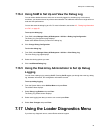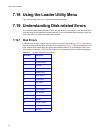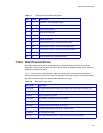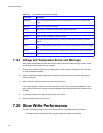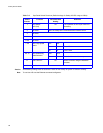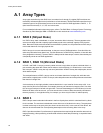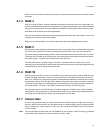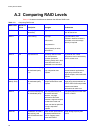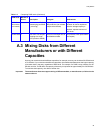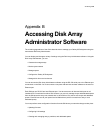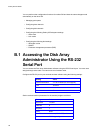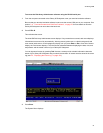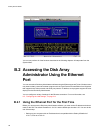Array Basics
91
RAID 3 is not well suited for transaction processing or other applications that require simultaneous reads
and writes.
A.1.4 RAID 4
RAID 4 is similar to RAID 3 in that the redundant information is achieved in the form of parity data. The
user data is distributed across all but one of the disks. The Galaxy 65 Subsystem uses a single, dedicated
parity drive for data protection. The main difference is that RAID 3 usually synchronizes writes to its disks,
while RAID 4 can send data to its disk independently.
RAID 4 is best suited for transaction processing applications that require high read requests, but not write
requests such as inquires rather than updates.
RAID 4 is not recommended for I/O-intensive applications that require high data transfer rates.
A.1.5 RAID 5
RAID 5 arrays contain redundant information in the form of parity data, which is calculated block-by-block
for all user data. The parity information is distributed across the disks in the array and occupies the
equivalent capacity of approximately one disk. Data is interspersed with the parity information. If one disk
in the array fails, the data on the failed disk can be reconstructed from the parity data and user data on
the remaining disks. Two disks must fail before the entire array fails.
The read performance of a RAID 5 array is excellent, comparable to that of a RAID 0 array. Write
performance is lower than that of a RAID 0 array, because write operations involve calculating and writing
new parity data as well as writing the new user data.
A.1.6 RAID 50
RAID 50 arrays are made up of two or more RAID 5 arrays, across which data is striped. RAID 50 arrays
contain redundant information in the form of parity data, which is calculated block-by-block for all user
data. As in a RAID 5 array, the parity information is distributed across the disks in the array and occupies
the equivalent capacity of one disk per RAID 5. Data is interspersed with the parity information. If one disk
in the array fails, the data on the failed disk can be reconstructed from the parity data and user data on
the remaining disks. Two disks in one RAID 5 subset must fail before the entire array fails.
The read performance of a RAID 50 array is excellent—better than a RAID 5 array—along with better
data protection. Write performance is lower than that of a RAID 0 array, because write operations involve
calculating and writing new parity data as well as writing the new user data.
A.1.7 Volume Sets
A volume set provides the ability to create a host-accessible LUN that maps to a single disk in the array,
similar to JBOD. Volume sets are non redundant and have a capacity slightly less than the physical disk
they are created from. Volume sets are useful if you have a single disk available and you do not want to
use it as a spare.
Note
For more information on RAID levels, see The RAIDbook: A Source Book for RAID Technology, published
by the RAID Advisory Board (St. Peter, Minnesota, February, 1996).



